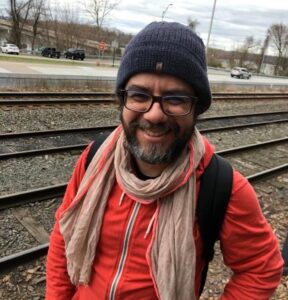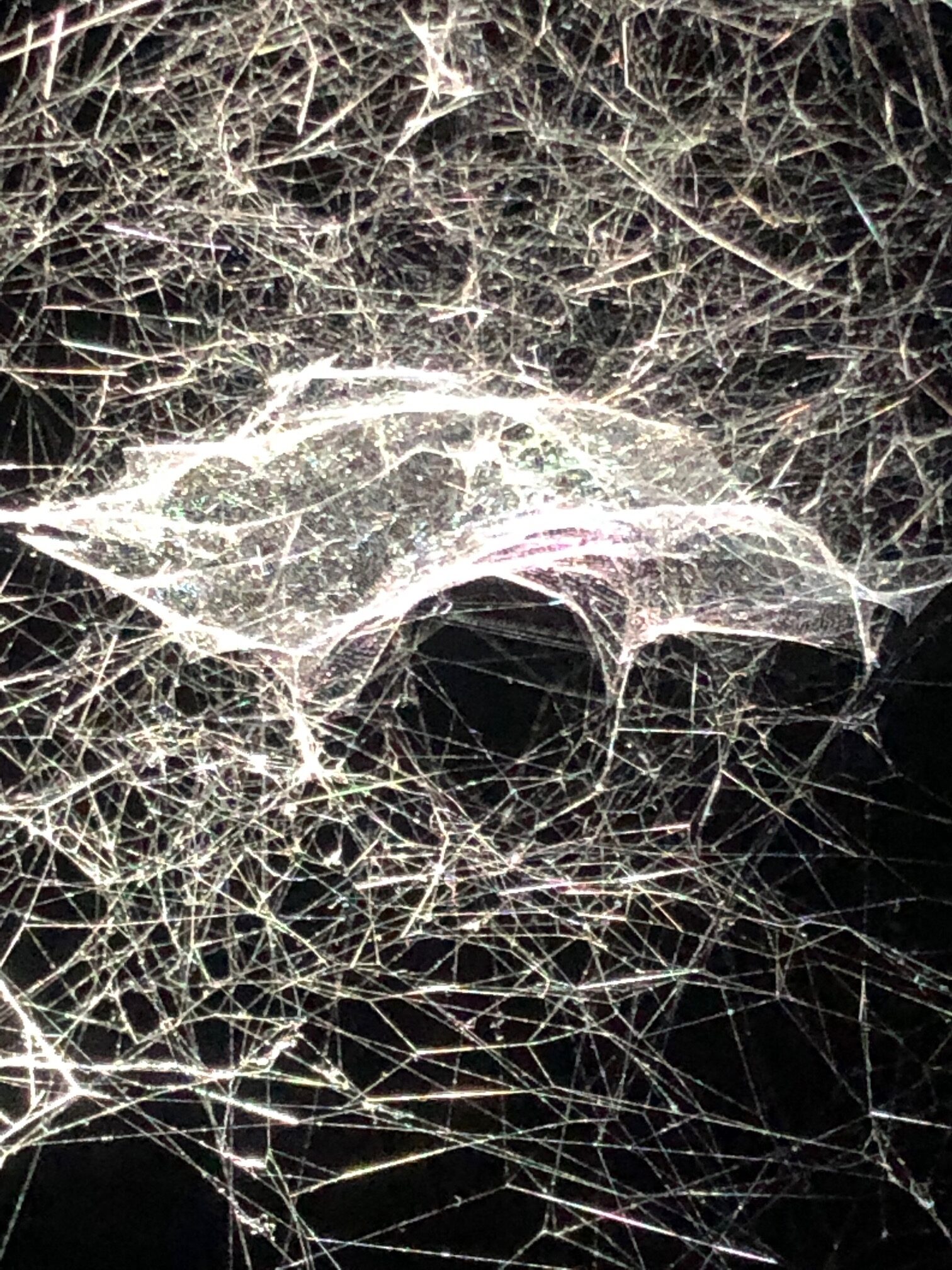
The Classroom as Webs – Teaching Like a Spider
This semester I am teaching a class called Theology and the Arts. In this class we are engaging the earth with the five senses of the body. During our last class we engaged the sense of vision and read about it. To see is modernity’s main sense; to see is to know, to define, to control, to classify, to order, to establish regulations and distinctions, rules and limits. To see is to establish or hide delineating social markers such as color/redlining, gender and sexuality, class, abled bodies, citizenship, and so on. Colonization is the mastering of a certain vision over the others’ vision. You have to see what I see. A view of the world means a way of living in the world. The panopticon is now the 24/7 surveillance that watches everyone. Control of vision is among the new forms of coloniality in the social sciences and scientific work as well, all marked by objective lenses and detached views.
 After our discussion we went to The Shed in New York city to see the exhibition Particular Matter(s) by the Argentinian artist Tomás Saraceno. The exhibition has several rooms showing particles and spider webs, but I will just describe the one named Free the Air: How To Hear the Universe In a Spider/Web, 2022. A huge round courtyard is organized in two levels of wire mesh nets, one suspended 12 feet above the floor and the other very high up at 40 feet. After about two minutes of walking on the net, you lay down, the doors are closed, and darkness takes over the room. You feel a mist flowing and you start to hear sounds from microphones attached to the net as well as vibrations throughout the net. Saraceno describes:
After our discussion we went to The Shed in New York city to see the exhibition Particular Matter(s) by the Argentinian artist Tomás Saraceno. The exhibition has several rooms showing particles and spider webs, but I will just describe the one named Free the Air: How To Hear the Universe In a Spider/Web, 2022. A huge round courtyard is organized in two levels of wire mesh nets, one suspended 12 feet above the floor and the other very high up at 40 feet. After about two minutes of walking on the net, you lay down, the doors are closed, and darkness takes over the room. You feel a mist flowing and you start to hear sounds from microphones attached to the net as well as vibrations throughout the net. Saraceno describes:
Unheard voices become felt vibrations in this arachnid concert in four movements. The first movement of the concert is a quiet period, providing an opportunity to detect subtle signals from subsurface seismic sources that would have been concealed in noisier times… These vibrations were created from recordings of the Earth, including the movement of air particles and the spider/webs on view in the exhibition. [The sounds are like] an aria from Grandmother Spider, played by a solo Trichonephila clavipes, as she plots and maps her web of life… The rhythm of vibrating spider/webs—more audible since the pandemic-affected reduction of anthropogenic seismic noise—invite visitors to extend their senses towards new forms of embodied cognition.
Yes indeed: new forms of embodied cognition. Spiders do taste and smell but their strongest sensorial organs are their legs. They sense vibrations through hairs and can “hear” these vibrations from 10 feet away. This “sixth sense” helps them discern the size and weight of things caught in their web. The students and I were trying to learn about cognitive variations by considering cognition from a spider’s perspective. Or perceiving or knowing the world through varieties of senses. (There were no spiders anywhere and we did not engage any.)
I had to prepare myself before we went. Just knowing that I was going to be locked in a totally dark room produced a lot of anxiety in me. I had to decide if I could face it, so I meditated in darkness throughout the week. I talked to my psychoanalyst about it and asked my brother Greg Snyder, a Buddhist priest and scholar, to teach me how to wrestle with my fears. In our exchange of text messages, he wrote this for me:
Breathe. Feel the energy of the anxiety in your body. Don’t concern yourself with the thoughts. Treat them like phantoms. Feel into the actual energetic force without needing to call it anxiety. Then allow that energy to be swept up by the current of the breathing, as if the banks of a river were eroding into the river itself. As the energy joins the breath, it will find the rhythm of the breath. Syncing the energy of the anxiety with the rhythm of the breath will give space and movement to that energy in ways that allow the system to calm down. Any excess anxious energy that cannot join the breath can be channeled down into the heart of the earth. Feel your feet on the ground. Feel your connection to the earth. When you exhale, train yourself to exhale down into the earth. So you are inhaling energetically up from the center of the earth and exhaling down into the earth. As the anxious energy joins your breath, exhale that energy with the current of the breath down into the vast warmth of the earth. Inhale the vast warmth back up into the body. Exhale the anxious energy back down, each time the energy dissipating into the vastness and warmth of the earth, each time inhaling vastness and warmth, spaciousness and strength.
This guidance truly prepared me for the experience. When we got there, I was tense but still determined to go. We were divided into those who would go into the 40-foot-high web or the 12-foot-high web. I was the only one on the 12-foot web. I told my students this was a huge challenge for me and they were very compassionate. I was embarrassed to be so vulnerable with my students but they were a group I could trust. We hear “Never trust your students, you never know what might come to you!” on the grapevine. This can be true. But sometimes it isn’t. They were immensely gentle and kind to me.
While laying down on the net I had an incredible experience, one I cannot fully describe. It was an experience without feelings. I didn’t feel anxious, fearful, or joyful. It was close to feeling happy. The web felt like an earth womb; I felt I was laying down in the vastness of the universe. The sounds of the earth were sparkling sensations. The net vibrated and my body felt that intensely—almost an out-of-body experience lived fully in every inch of my body. Everything was in movement but at its own pace. It was as if the sounds and vibrations and forms of relations manifested in the dark had always been in my body and I was visiting the earth at its very formation. No anxiety, no hope, no fear, no desire, no love. Just a sense of what I could call fullness: past, present, and future disappeared.
Another experience was very distinctive: I felt the wonder of perceiving the world from the perspective of another species. Well, sort of…. I have never before felt a sense of otherness so powerfully in my body. The awareness of that totally different world made me feel absolutely distinct; foreign and lost in every possible way. The worlds of the spider are truly something else. The way they live, connect, build their nets, perceive, engage, protect, hunt, hear, and see—everything has its own wisdom and language. The wonder was that in all its strangeness, the spiders’ worlds live in codependence with mine and with so many other worlds. A multiverse! In my house, they are building worlds in different places and they can sense my presence 3 meters away. As much as I might fear spiders, my awe and wonder for them now moves me towards respect, honor, and reciprocity.
After the event my body was completely exhausted, like I was carrying the tiredness of all the years of my life. It took a whole week to go away.
The connections between this experience and my classrooms are so many and I am still pondering it all: if a classroom is a web, we are literally entangled together. Hopefully not to eat each other up but to foster “net-works” of care and refuge. I need to learn to perceive my students not just with the objective eye of academia and checking their written work. I also need to perceive the pulsing of their hearts, the sounds they make, the fears they bring, the hopes they have, the anger they carry, the longings they vibrate. The classrooms as webs are like many worlds interlocked and we as spiders are catching the various sounds of the worlds, of people, and other species around us. Mostly blind to what we can’t see, we are trying to figure out sounds, vibrations, and temperatures around us. Depending on each other, different worlds making space for each other, holding each other in deep care as we discern how to live.
I wish I was a spider! And my classes were spider webs!
Leave a Reply